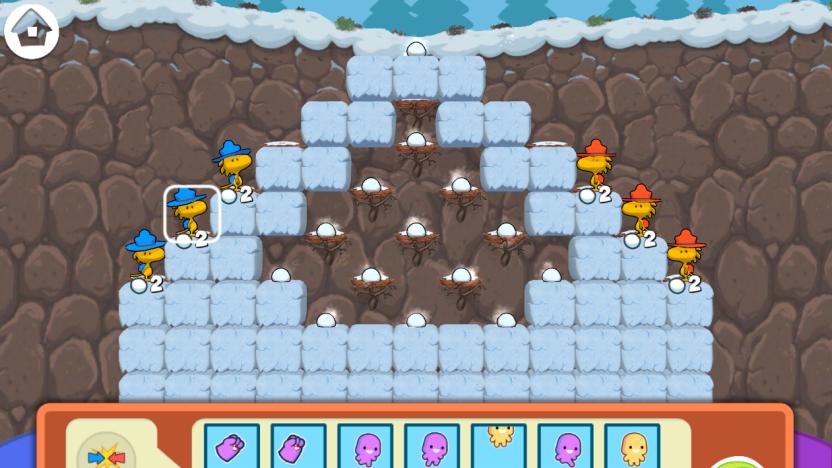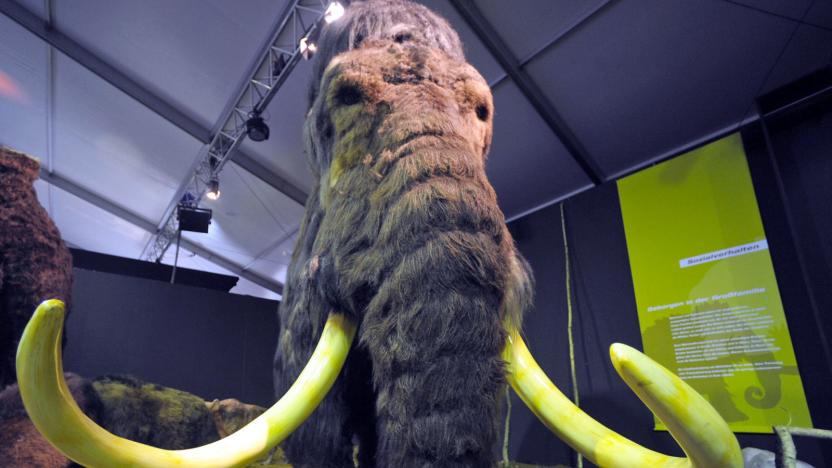sequencing
Latest

Microbiome testing startup faces FBI investigation over billing
Another lab testing startup is facing legal scrutiny, albeit not for the same reasons as Theranos. The Wall Street Journal has learned that the FBI is investigating uBiome, a firm that tests microbiomes (the communities of organisms in your body) to inform your health decisions, over its "billing practices." Agents reportedly conducted a search of uBiome's offices on April 26th, with the FBI confirming that it had visited the address.

Snoopy is your latest coding teacher
Snoopy is taking a break from lying on his doghouse and staring at the sky to help kids learn about computers and coding. As part of Computer Science Education Week (December 4-10), codeSpark Academy and the Peanuts brand are teaming up to release holiday-themed Snoopy Snow Brawl, a cute multi-player coding game that encourages kids to use problem-solving, strategy and algorithms in a snowball fight between Woodstock and his bird buddies, refereed by Snoopy.

Scientists find a low-cost way to build genomes from scratch
To put it mildly, sequencing and building a genome from scratch isn't cheap. It's sometimes affordable for human genomes, but it's often prohibitively expensive (hundreds of thousands of dollars) whenever you're charting new territory -- say, a specific person or an unfamiliar species. A chromosome can have hundreds of millions of genetic base pairs, after all. Scientists may have a way to make it affordable across the board, however. They've developed a new method, 3D genome assembly, that can sequence and build genomes from the ground up for less than $10,000.

Humanity is on the cusp of de-extincting the Wooly Mammoth
After successfully extracting sequenceable DNA from a pair of Woolly Mammoth carcasses pulled from Siberia's permafrost in 2014, a team of Harvard researchers announced on Thursday that they are tantalizing close to cloning the (currently) extinct pachyderms.

23andMe stops work on advanced gene sequencing
The team at 23andMe is dialing back some of its grander plans for DNA analysis. Co-founder Anne Wojcicki has confirmed to BuzzFeed News that her company has stopped working on next-generation sequencing that would reveal much more about your genes, such as the potential for some diseases. The executive is quick to stress that this isn't due to financial or regulatory trouble -- rather, it's a question of whether or not that data is useful enough to warrant 23andMe stretching itself thin at this point. The firm would rather focus on its "core business" right now, Wojcicki says.

DNA sequencing shows how woolly mammoths got that way
In what is being called the "most comprehensive" study of its kind, a team from the University of Chicago claims that it has revealed the massive amount of genetic change needed for woolly mammoths to adapt to their arctic environment. The study, which was published on July 2 in Cell Reports, shows that genes controlling everything from skin and hair development to fat metabolism, insulin signaling -- even skull shape -- differed from their contemporary elephant kin.

Human gene sequencing gets an official yardstick
Gene sequencing, once a rare feat, is pretty common these days... but how do you know that your DNA data is up to snuff? As of now, there's an easy way to find out. The National Institute of Standards and Technology (NIST) has released reference genetic material that serves as a "measuring stick" for human gene sequencing. Researchers have tested this sample genome so thoroughly that it'll tell labs whether or not they're making typical mistakes, and ensure that their results are trustworthy. The hope is that you'll see bulletproof sequencing devices that take the anxiety out of pinpointing genetic conditions or understanding your ancestry. [Image credit: Gerald Barber, Virginia Tech University (with permission of the National Science Foundation)]

The UK will decode the genes of 100,000 people to help fight cancer
The UK is about to launch one of the more ambitious attempts at using genetic research to fight cancer and other nasty diseases. The National Health Service's England branch plans to collect and sequence the genomes of 100,000 people in hopes of understanding both how DNA affects these sicknesses (such as gene-specific causes or symptoms) and what doctors can do to test and treat patients. The strategy will see the NHS run 11 specialized Genomic Medicine Centres across England, with more due in the future. So long as everything goes smoothly, the first recruits will sign up in February.

Google Genomics can store your entire genome online for a mere $25 a year
Google's been working on its latest project for about a year and a half ago: it's service that will store entire copies of genome. This isn't something Google Drive can cope with - decoding DNA involves a lot of data. According to Technology Review, in raw data, one person's genome weighs in at around 100 gigabytes. The plan is house all that DNA data online, in big 'ole clouds where scientists will be able to run virtual experiments and collaborate with each other on bigger (hopefully disease-curing) projects. Google is battling against the likes of Amazon and Microsoft to store expansive medical data like this: the Mountain View company charges scientists and researchers $25 a year for storing a single human genome -- although you'll have to pay a little more to fiddle around with data.

Max Planck Institute sequences genome of Siberian girl from 80,000 years ago, smashes DNA barriers
We've known little of the genetic sequences of our precursors, despite having found many examples of their remains: the requirement for two strands in traditional DNA sequencing isn't much help when we're usually thankful to get just one. The Max Planck Institute has devised a new, single-strand technique that may very well fill in the complete picture. Binding specific molecules to a strand, so enzymes can copy the sequence, has let researchers make at least one pass over 99.9 percent of the genome of a Siberian girl from roughly 80,000 years ago -- giving science the most complete genetic picture of any human ancestor to date, all from the one bone you see above. The gene map tells us that the brown-skinned, brown-eyed, brown-haired girl was part of a splinter population known as the Denisovans that sat in between Neanderthals and ourselves, having forked the family tree hundreds of thousands of years before today. It also shows that there's a small trace of Denisovans and their Neanderthal roots in modern East Asia, which we would never have known just by staring at fossils. Future discoveries could take years to leave an impact, but MPI may have just opened the floodgates of knowledge for our collective history.

Harvard stores 704TB in a gram of DNA, may have us shopping for organically-grown storage (video)
Early research has had DNA making circuits and little factories. We haven't really seen DNA used as a storage medium, however, and it's evident we've been missing out. A Harvard team led by George Church, Sriram Kosuri and Yuan Gao can stuff 96 bits into a DNA strand by treating each base (A, C, G, T) as though it's a binary value. The genetic sequence is then synthesized by a microfluidic chip that matches up that sequence with its position in a relevant data set, even when all the DNA strands are out of order. The technique doesn't sound like much on its own, but the microscopic size amounts to a gigantic amount of information at a scale we can see: about 704TB of data fits into a cubic millimeter, or more than you'd get out of a few hundred hard drives. Caveats? The processing time is currently too slow for time-sensitive content, and cells with living DNA would destroy the strands too quickly to make them viable for anything more than just transfers. All the same, such density and a lifespan of eons could have us turning to DNA storage not just for personal backups, but for backing up humanity's collective knowledge. We're less ambitious -- we'd most like to know if we'll be buying organic hard drives alongside the fair trade coffee and locally-sourced fruit.

MinION USB stick decodes DNA in a matter of seconds
If you happen to be "special," then this $900 USB device is just about the worst thing ever. The aptly named MINion serves its masters by interrogating the cells of living organisms and rooting out their genetic secrets. We won't pretend to know exactly how it works, but it starts by pulling a strand of DNA through a razor-like nanotube that unzips the double helix. The nucleotide bases are then electrocuted one by one until they give up their code. The resulting sequence is stored like a ticker-tape readout, for the whole world to see. The MinION can complete its task in seconds and, unlike most other DNA sequencers, it's portable and simply plugs into a laptop. Luckily, it has so far only been shown to work on very short genomes, like those belonging viruses and bacteria, so for now you're probably safe.

Archon Genomics X Prize offers up $10 million for sequencing 100 human genomes
Sure, we've come to love the X Prize for all of its crazy futuristic car building and moon racing contests, but the latest competition is decidedly smaller -- at least in one sense. For the Archon Genomics X Prize, the foundation is asking teams to sequence "medical grade" human genomes -- 100 of them, in fact -- using the DNA of 100 centenarians (folks who've made it to the ripe old age of 100), referred to pithily as the "Medco 100 Over 100." The centenarian DNA may contain secrets to overcoming disease -- after all, they made it to 100 for a reason. The competition opens to teams on January 3rd of next year -- once completed, the data gathered will be opened up to researchers. Press info can be unlocked after the break.

Researchers to map Ozzy Osbourne's genome
Ozzy Osbourne is about to join the ranks of a very fortunate (or unfortunate, depending on how you look at it) minority. DNA research lab Knome has announced that it is going to sequence the lead singer of Black Sabbath's entire genome. Knome, -- which focuses on DNA sequencing in the interest of disease research -- has said that Ozzy's "extreme" medical history (i.e., years of hard partying) makes him an ideal candidate for their purposes. Very few people have had their entire DNA mapped, and the sequencing will take about 3 months to complete, so we'll just have to make do by watching the video after the break until we get the results.





